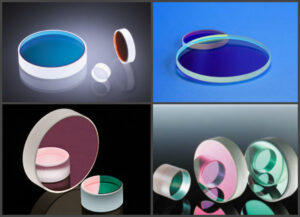 A Bragg mirror (also known as distributed Bragg reflector / dielectric mirror) is a type of mirror consist of composite thin layers of dielectric material, usually settled on a substrate of glass or other optical material. By careful choice of the type and thickness of the dielectric layers, one can project optical coating with specified reflectivity at various wavelengths. Bragg mirrors can be adapted to obtain any reflectivity between 0% and nearly 100% for a specific target wavelength.
A Bragg mirror (also known as distributed Bragg reflector / dielectric mirror) is a type of mirror consist of composite thin layers of dielectric material, usually settled on a substrate of glass or other optical material. By careful choice of the type and thickness of the dielectric layers, one can project optical coating with specified reflectivity at various wavelengths. Bragg mirrors can be adapted to obtain any reflectivity between 0% and nearly 100% for a specific target wavelength.
Different technologies can be used to fabricate Bragg mirrors. First are the thin-film coating technology, fabricated, for example, by electron beam evaporation or with ion beam sputtering. These technologies are used as laser mirrors in solid-state bulk lasers. Second are Fiber Bragg gratings, including long-period fiber gratings, which are often used in fiber lasers and other fiber devices. They can be fabricated by irradiating a fiber with spatially patterned ultraviolet light. Next, are lithographic methods for semiconductor Bragg mirrors. They are used, for example, in surface-emitting semiconductor lasers and semiconductor saturable absorber mirrors, but also as separate optical components.
There are also different types of Bragg reflectors used in other waveguides, based on, for example, corrugated waveguide structures that can be fabricated via lithography. Such kind of gratings is used in some distributed Bragg reflector or distributed feedback laser diodes.
There are some advantages of using Bragg mirrors:
- Low-loss, if the dielectric material is transparent to the wavelength under study. That means it can exhibit ultra-high reflectance, useful for a high-Q cavity.
- Broadband. It can be as broad as metal, at a much higher reflectance.
- Foreseeable reflection phase.
Bragg mirrors found their applications in laser cavity end mirrors, hot and cold mirrors, thin-film beam splitters, and the coatings on new-day mirrorshades.

